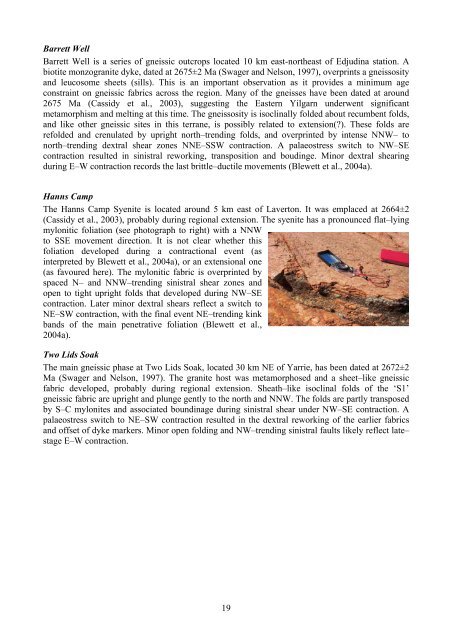Tectonostratigraphic architecture and uplift history of the Eastern ...
Tectonostratigraphic architecture and uplift history of the Eastern ...
Tectonostratigraphic architecture and uplift history of the Eastern ...
You also want an ePaper? Increase the reach of your titles
YUMPU automatically turns print PDFs into web optimized ePapers that Google loves.
Barrett WellBarrett Well is a series <strong>of</strong> gneissic outcrops located 10 km east-nor<strong>the</strong>ast <strong>of</strong> Edjudina station. Abiotite monzogranite dyke, dated at 2675±2 Ma (Swager <strong>and</strong> Nelson, 1997), overprints a gneissosity<strong>and</strong> leucosome sheets (sills). This is an important observation as it provides a minimum ageconstraint on gneissic fabrics across <strong>the</strong> region. Many <strong>of</strong> <strong>the</strong> gneisses have been dated at around2675 Ma (Cassidy et al., 2003), suggesting <strong>the</strong> <strong>Eastern</strong> Yilgarn underwent significantmetamorphism <strong>and</strong> melting at this time. The gneissosity is isoclinally folded about recumbent folds,<strong>and</strong> like o<strong>the</strong>r gneissic sites in this terrane, is possibly related to extension(?). These folds arerefolded <strong>and</strong> crenulated by upright north–trending folds, <strong>and</strong> overprinted by intense NNW– tonorth–trending dextral shear zones NNE–SSW contraction. A palaeostress switch to NW–SEcontraction resulted in sinistral reworking, transposition <strong>and</strong> boudinge. Minor dextral shearingduring E–W contraction records <strong>the</strong> last brittle–ductile movements (Blewett et al., 2004a).Hanns CampThe Hanns Camp Syenite is located around 5 km east <strong>of</strong> Laverton. It was emplaced at 2664±2(Cassidy et al., 2003), probably during regional extension. The syenite has a pronounced flat–lyingmylonitic foliation (see photograph to right) with a NNWto SSE movement direction. It is not clear whe<strong>the</strong>r thisfoliation developed during a contractional event (asinterpreted by Blewett et al., 2004a), or an extensional one(as favoured here). The mylonitic fabric is overprinted byspaced N– <strong>and</strong> NNW–trending sinistral shear zones <strong>and</strong>open to tight upright folds that developed during NW–SEcontraction. Later minor dextral shears reflect a switch toNE–SW contraction, with <strong>the</strong> final event NE–trending kinkb<strong>and</strong>s <strong>of</strong> <strong>the</strong> main penetrative foliation (Blewett et al.,2004a).Two Lids SoakThe main gneissic phase at Two Lids Soak, located 30 km NE <strong>of</strong> Yarrie, has been dated at 2672±2Ma (Swager <strong>and</strong> Nelson, 1997). The granite host was metamorphosed <strong>and</strong> a sheet–like gneissicfabric developed, probably during regional extension. Sheath–like isoclinal folds <strong>of</strong> <strong>the</strong> ‘S1’gneissic fabric are upright <strong>and</strong> plunge gently to <strong>the</strong> north <strong>and</strong> NNW. The folds are partly transposedby S–C mylonites <strong>and</strong> associated boundinage during sinistral shear under NW–SE contraction. Apalaeostress switch to NE–SW contraction resulted in <strong>the</strong> dextral reworking <strong>of</strong> <strong>the</strong> earlier fabrics<strong>and</strong> <strong>of</strong>fset <strong>of</strong> dyke markers. Minor open folding <strong>and</strong> NW–trending sinistral faults likely reflect late–stage E–W contraction.19

















